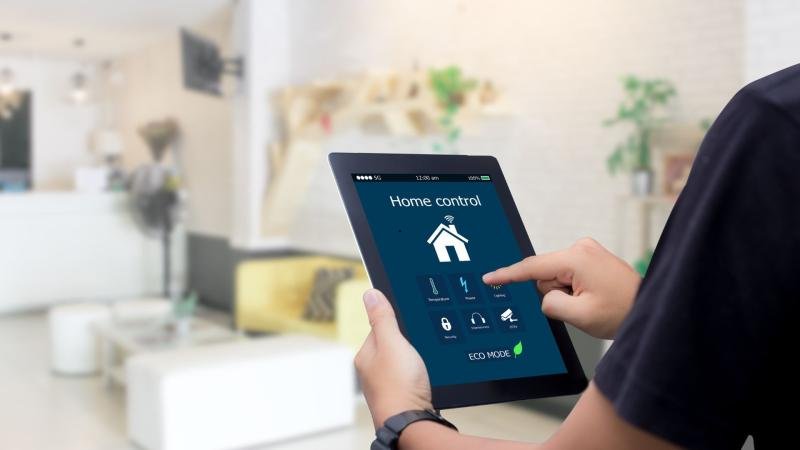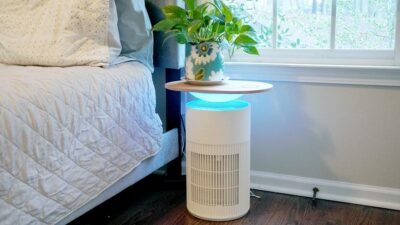India Home Automation Market Overview
The forecast for the Indian home automation market is influenced by the increasing adoption of smart home appliances, including voice assistants, security systems, thermostats, and bright lighting. For instance, a staggering 90% of televisions purchased in 2023 were smart TVs. Even smaller communities are embracing this technology; thus, the phenomenon is not limited to big cities. Consumers are spending more on smart gadgets to enhance convenience, security, and energy efficiency, driven by increased disposable incomes and declining technological costs. The trend is also driven by a growing understanding of the benefits of smart homes, including automation and remote control through mobile apps.
Furthermore, users can design unique home settings that cater to their needs by integrating AI and IoT into home automation technologies. The development of smart cities and government programs to encourage the use of technology in urban areas are contributing factors to this trend, which is propelling the growth of the home automation market in India.
Network Type
• Wired
• Wireless
• Power Line Based
According to Renub Research, the India home automation market is anticipated to grow at a compound annual growth rate (CAGR) of 16.21% from 2025 to 2033, from US$ 3.86 billion in 2024 to US$ 14.93 billion by 2033.
Components of a Home Automation System
Central Hub or Controller
To organize and control all linked devices, the central hub-often referred to as the brain of a home automation system-is essential. It serves as the primary interface that enables various smart devices to interact and collaborate. Central hubs can be integrated into smart speakers like Google Home or Amazon Echo, or they can be independent devices, such as Samsung SmartThings. With the help of these hubs, users can manage and operate a variety of smart devices more efficiently by controlling every aspect of their home setup from a single app or interface. To ensure compatibility with a wide range of devices and facilitate the smooth integration and growth of the home automation network, they often support various wireless protocols.
Sensors
To provide the data required for automatic reactions and monitoring, sensors are essential components of a home automation system. When motion is detected by motion sensors, devices such as lights and security cameras are activated. Entry point opening and closing are tracked by door and window sensors, which enhance security by notifying users of any unauthorized access. The system can regulate heating, cooling, and ventilation for maximum comfort and energy efficiency thanks to temperature and humidity sensors that monitor the surrounding environment. By continually providing real-time data to the central hub, which subsequently makes choices based on user preferences and predetermined settings, these sensors help create a responsive and intelligent home environment.
Product
• Smart Speaker Market
• Security Camera
• Smart Doorbell
• Smart light
• Smart Door lock
• Smart Switch
• Smart Sensor
• Others
Key information covered in the report.
Base Year – 2024
Historical Period – 2020-2024
Market Forecast – 2025-2033
Market – US$ Billion
Request a free sample copy of the report: https://www.renub.com/india-home-automation-market-by-types-lighting-security-heating-ventilating-and-air-conditioning-hvac-entertainment-by-user-residential-commercial-and-hospitality-company-profiles-and-forecast-1013-p.php
Home automation advantages include:
Energy monitoring
To help their customers track their electricity usage, several home automation companies offer energy consumption monitoring systems. Intelligent and flexible home automation systems are being developed. Smartphones and wireless data services have advanced significantly due to the recent rapid development cycles in the home automation market.
Sensors for gas leaks and smoke trigger local alarms. To ensure security, they may also be centrally monitored in large buildings.
Care for the elderly and crippled
Users may now utilize a smartphone app to operate their houses, thanks to home automation firms. Sensors and automated door locks are examples of smart home devices that give their customers protection and freedom.
Parents who work
Working parents spend a lot of time caring for their kids, but home automation may help with this tiresome task. Parents who go to work every day may use internet technologies to monitor their children and check in on them, thanks to smart security.
Segment Type
• Appliances
• Energy Management
• Entertainment
• Security
• Control Connectivity
What impact will 5G and AI developments have on India’s smart home market?
By making homes more intelligent, sensitive, and connected, AI and 5G developments are poised to alter India’s smart home market significantly. These technologies will influence the industry in the following ways:
AI’s Impact on Smart Home Automation and Personalization:
AI algorithms will analyze user habits, preferences, and behavior to automate home tasks such as regulating lights, temperature, and appliances, resulting in a highly personalized living space. Smart thermostats, for instance, will automatically adjust the temperature for comfort and energy efficiency based on regular patterns.
Enhanced Security: AI-powered security systems will utilize facial recognition, anomaly detection, and sophisticated monitoring to differentiate between suspect and routine activities, promptly informing authorities or homeowners. This will significantly enhance access control and home safety.
The Effect of 5G on Ultra-Fast Connectivity in Smart Homes:
A large number of smart gadgets will be able to communicate in real time thanks to the high-speed, low-latency connections offered by 5G networks. Instantaneous replies and smooth home system integration will be made possible by this.
Scalability and Device Density: 5G enables a significantly higher number of connected devices per household, making it easier to grow smart home ecosystems to include everything from electric car chargers to kitchen appliances and security cameras.
Collective Effect: The Prospects for Smart Homes in India
Smooth Interoperability: When AI and 5G are combined, devices will be able to coordinate and communicate with one another, forming a single, intelligent ecosystem where entertainment, security, and lighting systems all work together seamlessly to enhance comfort and convenience.
Greater Adoption and Affordability: Smart home solutions will become more widely available outside of metro areas, reaching Tier 2 and Tier 3 cities, as well as the middle class, as expenses decrease and infrastructure advances.
Distribution Channels
• System Integrator
• Manufacturer
• Retailer
Customer Spending on Home
• Less than 15000
• 15001-30000
• 30001-45000
• 45001-60000
• More than 60001
India’s Home Automation Future
• India has a big building sector. Home automation will catch up with the latest trends in areas like Bangalore, where building is booming.
• Strong product development is the main emphasis of home automation firms.
• The development of home automation systems will result from this.
• Soon, all of us will be residing in an assisted living facility. Access to assisted reality will grow, and it will be applied to routine chores. The newest voice-activated gadgets that make home automation simple and accessible are Google Home and Amazon’s Alexa.
• The market is expanding due to the increasing availability of Internet-connected devices and the growing popularity of automated systems that can be controlled over fast Wi-Fi using a capable smartphone. In the coming years, the home automation industry is expected to grow due to lower energy consumption and a wider range of products.
• With an annual growth rate of over 7%, India is a rapidly growing economy. The consumption bug has bitten Indians, and at least the top half of all wage earners have an ever-increasing income rate. A three-bedroom apartment in a big city typically costs Rs 1.5 crore, plus another 20 lakhs for furniture. Spending a little more to upgrade to a bright house won’t bother new homebuyers.
End User
• Residential
• Commercial
Regional Analysis of India Home Automation Market
The home automation market in India varies by region due to factors such as technology adoption, economic levels, and urbanization. Because they have more discretionary income and are more receptive to new technology, Western cities like Mumbai and Pune are at the forefront. Cities in the south, including Bangalore and Hyderabad, are experiencing rapid growth due to the impact of the IT industry and a tech-savvy population. The growing need for energy-efficient technology and innovative urban projects is helping northern cities like Delhi and Chandigarh. Cities like Kolkata in Eastern India are gradually implementing it, primarily in areas such as lighting and security. With the help of government incentives and reasonably priced innovative solutions, rural areas are becoming marketplaces. Urban areas predominantly dominate the market, but Tier 2 and Tier 3 cities are gradually adopting it due to increasing affordability and awareness.
Region
• North India
• East India
• South India
• West
Cities
• Pune
• Delhi NCR
• Mumbai
• Hyderabad
• Ahmedabad
• Bengaluru
• Chennai
• Jaipur
• Kolkata
• Ludhiana
• Chandigarh
• Cochin
• Coimbatore
• Others
News from the Indian Home Automation Market:
Schneider Electric, a leader in the digitization of energy management and automation, introduced a ground-breaking line of products and solutions in July 2024 to create the next generation of smart buildings and homes. BuildCon 2024, Schneider Electric’s premier event, showcased the company’s cutting-edge Home Energy Management solutions under the theme “Future Forward – Switch to Smart.” It was one of the largest assemblies of Goan developers and contractors.
Company Analysis
• Koninklijke Philips
• Schneider Electric
• Johnson Controls
• Honeywell
• ABB
• Amazon (ECHO)
• Alphabet
New Publish Reports
Building Automation Systems Market: https://www.renub.com/building-automation-systems-market-p.php
Global Image-guided Therapy Systems Market : https://www.renub.com/image-guided-therapy-systems-market-p.php
Building Management System Market:https://www.renub.com/building-management-system-market-p.php
Media Contact:
Company Name: Renub Research
Contact Person: Rajat Gupta, Marketing Manager
Phone No: +91-120-421-9822 (IND) | +1-478-202-3244 (USA)
Email: mailto:rajat@renub.com
About the Company:
Renub Research is a Market Research and Consulting Company. We have more than 15 years of experience especially in international Business-to-Business Researches, Surveys and Consulting. We provide a wide range of business research solutions that helps companies in making better business decisions. We partner with clients in all sectors and regions to identify their highest-value opportunities, address their most critical challenges, and transform their businesses. Our wide clientele comprises major players in Healthcare, Travel and Tourism, Food Beverages, Power Energy, Information Technology, Telecom Internet, Chemical, Logistics Automotive, Consumer Goods Retail, Building, and Construction, Agriculture. Our core team is comprised of experienced people holding graduate, postgraduate, and Ph.D. degrees in Finance, Marketing, Human Resource, Bio-Technology, Medicine, Information Technology, Environmental Science, and many more.
This release was published on openPR.




